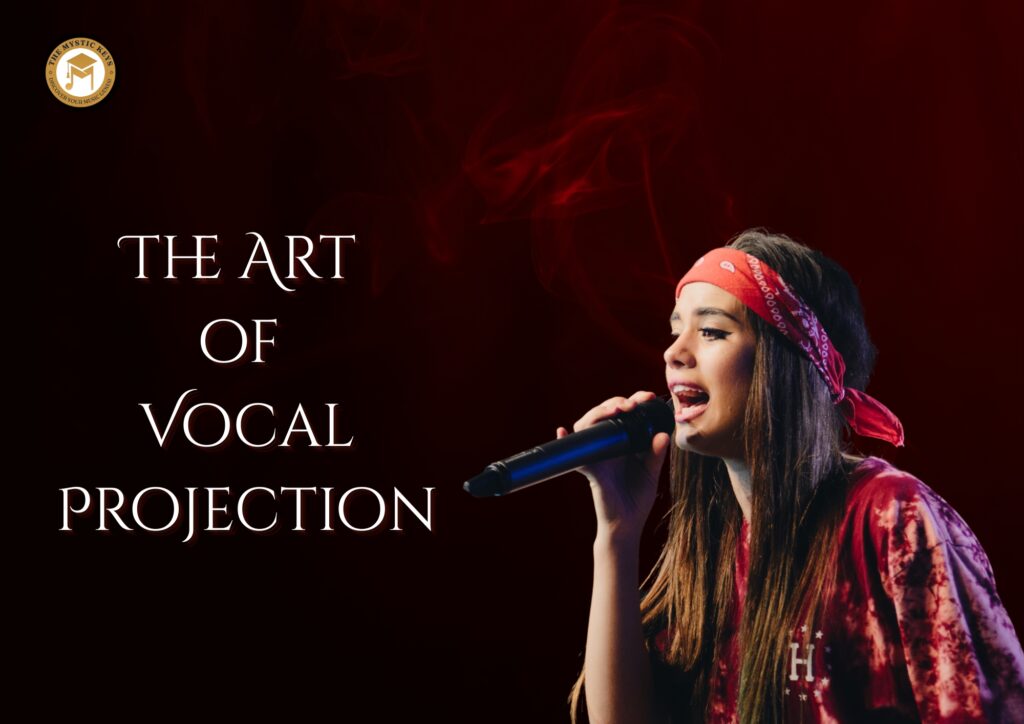The Art of Vocal Projection | Sing Louder Without Straining
Mastering the Art of Vocal Projection is a vital skill for any singer—whether you’re commanding a stage, leading a choir, or simply singing among friends. It’s not just about being loud; it’s about being heard with clarity, confidence, and emotion. However, achieving this level of vocal strength without straining or damaging your vocal cords is a challenge many vocalists face. That’s where technique becomes essential.
To sing with power, you must move beyond simply increasing volume. Instead, the focus shifts to improving resonance, breath support, and vocal clarity. When developed properly, vocal projection allows your voice to travel farther, sound fuller, and remain healthy through every performance.
In this blog, we’ll take a deep dive into the techniques and habits that define the Art of Vocal Projection—offering you actionable tips to sing louder, reach your audience more effectively, and do so without ever compromising your vocal health.

Understanding Vocal Projection
Vocal projection refers to the ability to direct your voice with strength and clarity, allowing it to carry over a distance without the need to shout or force volume unnaturally. This skill doesn’t come from sheer power—it comes from technique. It involves a seamless blend of breath support, vocal technique, posture, and resonance working together to produce a full, rich sound. Mastering this balance is what truly defines the Art of Vocal Projection—an essential skill for any serious vocalist.
To understand its importance, it helps to compare vocal projection with loud singing. At first glance, the two may seem similar, but they are quite different in execution and impact. Loud singing often relies on brute force, pushing the vocal cords beyond their comfort zone and leading to strain. In contrast, the Art of Vocal Projection uses natural resonance and proper technique to amplify the voice effortlessly. In other words, it’s not about singing harder—it’s about singing smarter. It’s the difference between shouting to be heard and letting your voice naturally fill the room with presence and power.

Breathing and Breath Support
A fundamental aspect of vocal projection is the control of breath. Proper breath support is critical because it allows the voice to carry without straining. When you sing, the sound is produced by the vibration of your vocal cords, but those vibrations need to be powered by air. This is where your diaphragm comes into play.
Breathing exercises to improve support:
Diaphragmatic Breathing: Place your hand on your stomach and take a deep breath. As you inhale, your stomach should expand, not your chest. This indicates you’re engaging your diaphragm. This deep, low breathing provides the air support needed for powerful vocal projection.
Controlled Exhalation: Practice exhaling slowly and steadily. Inhale for four counts, hold for four counts, then exhale slowly for eight counts. This helps increase your lung capacity and control.
Without proper breath control, singers often use their throat to force sound, leading to tension and vocal strain. Breath support minimizes this, giving your voice more power and endurance.

Posture | Standing Tall for Better Sound
How you position your body—whether standing or sitting—has a powerful impact on your vocal projection. This is because posture doesn’t just affect your appearance; it directly influences how your breath flows and how freely your voice can resonate. In other words, good posture lays the groundwork for strong, healthy sound production.
When your body is well-aligned, your lungs can fully expand, giving you better breath control. This, in turn, enhances your vocal strength and endurance. Additionally, proper posture reduces unnecessary tension in your muscles, especially around the neck and shoulders, which can otherwise interfere with the free movement of your vocal cords.
To put this into practice, consider the following posture tips that work together to support vocal projection:
-
Start with your feet shoulder-width apart: This provides a stable base, helping you feel grounded and balanced while singing.
-
Then, align your spine: Imagine a string gently pulling you upward from the crown of your head. This visualization helps elongate your neck and keep your spine upright, which creates space for your breath and vocal resonance.
-
Next, check your shoulders: Are they creeping upward with tension? Let them fall naturally and stay relaxed. Releasing this tension will immediately improve the ease and clarity of your vocal delivery.
-
Finally, lift your chest just slightly: Doing so opens up the rib cage and encourages deep, full breaths. With each inhale, you’ll feel more supported and capable of producing a strong, rich tone.
Altogether, these small adjustments create a posture that supports—not restricts—your singing. Once your body is aligned, balanced, and free of unnecessary tension, your voice will be able to travel with more ease, clarity, and power. This makes the Art of Vocal Projection not only more effective but also far more sustainable over time.

Avoiding Tension in the Throat
Singing louder without straining requires your vocal cords to function smoothly without unnecessary tension. Many singers unintentionally create tension in the throat by pushing too hard, forcing the sound, or overcompensating for a weak breath support system.
To avoid this tension:
-
Stay relaxed: Before you sing, take a few moments to relax your neck, shoulders, and jaw. Use gentle stretches to release any tightness.
-
Avoid pushing your voice: Resist the temptation to yell or shout. Focus on using proper support from your diaphragm to help your voice project.
-
Use your head voice for higher notes: The higher your note, the less strain you should feel in your throat. A strong head voice can help with higher pitches, providing more power without strain.
Always monitor the sensations in your throat. If you feel tension, stop and reassess your posture, breath, and vocal technique.

Resonance | Finding Your Natural Sound
Resonance is the quality of sound that is amplified and enriched by the spaces in your body, especially the chest, mouth, and sinuses. When singers learn to properly resonate their voices, they are able to sing more powerfully without relying on sheer volume.
One of the best ways to improve resonance is by working on your head voice and chest voice, learning how to blend them effectively. This approach gives your voice a natural richness that doesn’t need to be forced.
Exercises to improve resonance:
Humming: Hum through a note and feel the vibrations in your face, nose, and chest. This encourages the right kind of resonance.
Lip trills: Trilling your lips up and down helps to release tension and build resonance without straining.
Sirens: Glide from your lowest note to your highest and back down in a smooth motion, focusing on where you feel the vibrations in your body.
The more resonant your voice becomes, the less strain you’ll need to project sound effectively. Resonance allows you to fill a room with sound without straining your vocal cords.

Warm-Up and Cool-Down
Warming up before you sing and cooling down afterward are essential practices for maintaining a healthy voice, particularly when you’re aiming to sing loudly without straining.
Warm-up exercises:
Lip trills or sirens to gently loosen up the vocal cords.
Vocal slides from low to high pitches and back down.
Scales sung on different vowel sounds (ah, ee, oh, oo) help to gradually prepare the vocal cords for more demanding singing.
Cool-down exercises:
Gentle humming or soft singing to relax the vocal cords.
Light scales sung at a lower volume to avoid sudden tension after a performance.
By taking time to properly warm-up and cool-down, you help your vocal cords stay flexible and healthy, reducing the risk of injury and strain when projecting your voice.

Proper Vocal Technique and Practice
Mastering vocal projection requires consistent practice. The more you practice, the stronger and more flexible your voice becomes, allowing you to sing louder without strain. However, good technique is essential. Working with a vocal coach can help you refine these skills and avoid developing bad habits that could lead to vocal damage.
Key techniques to develop:
-
Breath control exercises: These exercises will help you learn to sing more powerfully without running out of air.
-
Resonance exercises: Engage in exercises that encourage vibrations in your chest, head, and mask (the area around your nose and cheekbones).
-
Dynamic control: Work on controlling the dynamics of your voice, learning how to sing both softly and loudly without shifting into a tense or forced tone.

Hydration and Vocal Health
A healthy voice is essential for effective vocal projection. When your vocal cords are properly hydrated, they remain flexible and better equipped to handle the demands of louder singing. Hydration, therefore, plays a pivotal role in ensuring your voice stays strong and resilient.
To start, drinking plenty of water is key. Keeping your body well-hydrated creates a moist environment for your vocal cords, which allows them to move smoothly and efficiently. Additionally, it’s important to avoid throat irritants such as alcohol, caffeine, and smoking. These substances can dry out your vocal cords, making it much more difficult to project your voice effectively.
In addition, gargling with warm salt water can provide soothing relief for any inflammation in your throat, helping to maintain vocal health. By staying hydrated and avoiding irritants, your voice will not only gain more flexibility but also become less ]prone to fatigue. This makes it easier to sing louder with less effort, allowing for more powerful and sustained vocal projection.

Mindset | Confidence and Relaxation
Your mindset can play a huge role in vocal projection. It’s not just about physical technique—your mental state influences how freely and confidently your voice flows. For instance, anxiety or fear about not being heard often triggers physical tension, especially in the neck and shoulders, which directly restricts your vocal ability. On the other hand, a calm and confident mindset can significantly enhance your sound, making your voice feel more grounded and powerful.
That’s why cultivating mental focus is just as important as mastering vocal exercises. Before singing, take a moment to breathe deeply, center yourself, and shift your mindset from fear to trust. Remind yourself that the Art of Vocal Projection is rooted in relaxation, not force. By trusting your breath support, tapping into your resonance, and relying on solid technique, you can allow your voice to naturally fill the space—without strain, panic, or hesitation.

Conclusion |Sing Loud and Healthy
Vocal projection is an essential skill for any singer aiming to reach a larger audience without causing damage to their voice. It goes beyond just singing louder—it’s about using your body efficiently and skillfully. By focusing on proper breath support, maintaining good posture, maximizing natural resonance, and embracing relaxation, you can gradually develop the ability to sing with greater power and clarity, all while avoiding unnecessary strain or vocal fatigue.
It’s important to understand that the Art of Vocal Projection is not about shouting or pushing your voice to its limits. Instead, it’s about allowing your voice to carry with ease by applying solid vocal techniques and aligning your body in a way that supports sound flow. As you continue to practice with consistency and pay attention to the finer details of your technique, you’ll notice a significant improvement in your projection—enabling you to perform confidently, whether in an intimate room or a grand concert hall.
If you’re ready to explore your full vocal potential, consider joining Western Vocal Lessons Online at The Mystic Keys. Our expert instructors will guide you through personalized techniques to build breath control, resonance, and projection—all in a supportive and engaging environment.
So, embrace the journey, stay mindful, and let your voice rise with strength and freedom.
Happy singing!
Related Blogs
Essential Vocal Warm-Up and Cool-Down Exercises for Singers
As a singer, whether you’re preparing for a performance, rehearsal, or even a recording session, taking care of your voice is essential. Vocal warm-up and cool-down exercises are an important part of maintaining vocal health and ensuring the best possible performance.
Can I learn western music
online?
The world of Western music is incredibly diverse, spanning from the grandeur of classical symphonies to the spontaneity of jazz improvisations and the catchy rhythms of contemporary pop.
When it comes to singing, smoothness and fluidity can elevate a performance to new heights. One of the key techniques used by vocalists to achieve seamless transitions between notes is the pitch glide.








